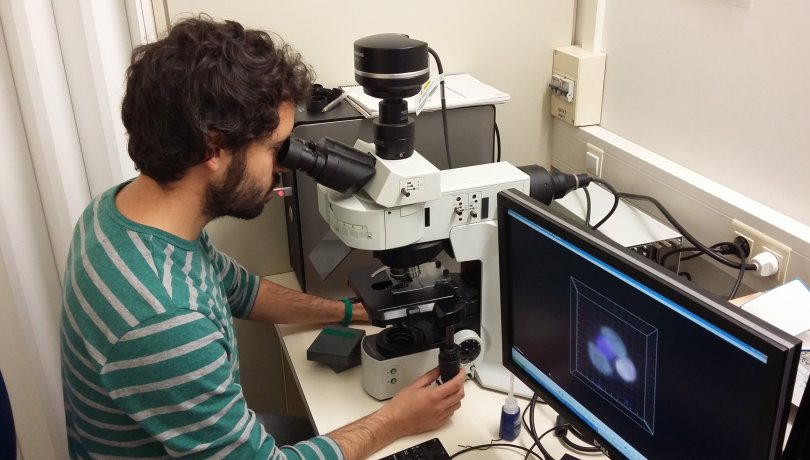A study led by researchers of the Institute of Marine Sciences (ICM) depicts the close symbiosis relationship between two microscopic marine organisms. In this relationship, cells of cyanobacteria live in symbiosis within unicellular algae, larger than the former ones, and both exchange nutrients. According to the results, this relationship is maintained since 90 million years ago and plays a key role in the nitrogen cycle in the oceans. The work is based on data from the Tara Oceans expedition and has been published in the journal Nature Communications.

A study led by researchers of the Institute of Marine Sciences (ICM) depicts the close symbiosis relationship between two microscopic marine organisms. In this relationship, cells of cyanobacteria live in symbiosis within unicellular algae, larger than the former ones, and both exchange nutrients. According to the results, this relationship is maintained since 90 million years ago and plays a key role in the nitrogen cycle in the oceans. The work is based on data from the Tara Oceans expedition and has been published in the journal Nature Communications.
The research focus on this symbiotic system composed by the UCYN-A cyanobacterium and a unicellular alga of the prymnesiophytes. In this convenience relationship, the cyanobacterium provides nitrogen to its host, the alga, while this makes photosynthesis and produces organic matter from carbon, which can benefit the symbiont.
The study also has implications in evolutionary biology since the host cells could have acted as a physical barrier to prevent the genetic exchange of cyanobacterial symbionts and that could have drawn their speciation. "The obligatory nature of this symbiosis together with the genome reduction suffered by UCYN-A and the expression of their genome content, mainly focused on nitrogen fixation, suggest that we are facing a similar evolutionary process that led to chloroplasts in plants, that is the formation of an organelle of bacterial origin whose function is to provide nitrogen to its host", explains the first author of the study, Francisco M. Cornejo, of the Ecology and Genomics of Marine Microorganisms Group at the ICM.
Despite nitrogen is hugely abundant in the atmosphere (up to 80%), most species cannot use it. However many organisms, such as legumes in terrestrial ecosystems, rely on bacteria to transform this atmospheric gas into nitrogen that can be used by the organisms of the food web. The symbiotic relationship between a host and microorganisms capable of fixing atmospheric nitrogen provides an adaptive advantage to both. This premise is also valid in marine environments, where nitrogen an essential component of amino acids in proteins and nucleic acids like the DNA, is one of the most limiting nutrient in the ocean primary production.
New species
The work provides epifluorescence microscopy images that show the specificity of this symbiotic system. In fact, researchers have identified two lineages of the couple host-symbiont, where species show slight differences between them. The study suggests that symbiosis has run the speciation process from a common ancestor to both described hosts, and also from another common ancestor to both symbionts. It also reveals the faithfulness of both symbioses that may live together in the same environment. "The microscopic characterization of this type of symbiosis is accentuated when dealing with organisms that cannot be cultivated, it is like looking for a needle in a haystack", says one of the co-authors of the work, Ana Maria Cabello, also from the ICM.
The two UCYN-A lineages diverged about 90 million years ago, just after a paleo-oceanographic context in which the lowest nutrient regime of the last 500 million years occurred. "A stage of scarce nutrients in the ocean could have led to the establishment of the symbiotic relationship between the algae and the cyanobacteria", explains one of the collaborators of the study, Patricia Sanchez-Baracaldo, of the University of Bristol in the UK.
"This is a very important symbiotic system in marine environments because they are globally distributed playing a significant role in nitrogen and carbon marine cycles", reveals Silvia G. Acinas, researcher at the ICM study leader and coordinator prokaryotes consortium of Tara Oceans from where the study data. " Tara Oceans is offering an incredible open dataset for further exploration of other marine symbiotic relationships. The stories are there, we just need people to discover them", concludes the researcher.
This work also involved researchers from several international groups, among others: University of Bristol (UK), VIB/VUB/KU Leuven (Belgium), Aix-Marseille University (France), Centre National de la Recherche Scientifique - CNRS (France), Genoscope (France), European Molecular Biology Laboratory - EMBL (Germany) and University of California (United States).
Paper
Francisco M. Cornejo-Castillo, Ana M. Cabello, Guillem Salazar, Patricia Sánchez-Baracaldo, Gipsi Lima-Mendez, Pascal Hingamp, Adriana Alberti, Shinichi Sunagawa, Peer Bork, Colomban de Vargas, Jeroen Raes, Chris Bowler, Patrick Wincker, Jonathan P. Zehr, Josep M. Gasol, Ramon Massana y Silvia G. Acinas. "Cyanobacterial symbionts diverged in the late Cretaceous towards lineage-specific nitrogen fixation factories in single-celled phytoplankton". Nature Communications 7:11071 doi: 10.1038/ncomms11071 (2016).